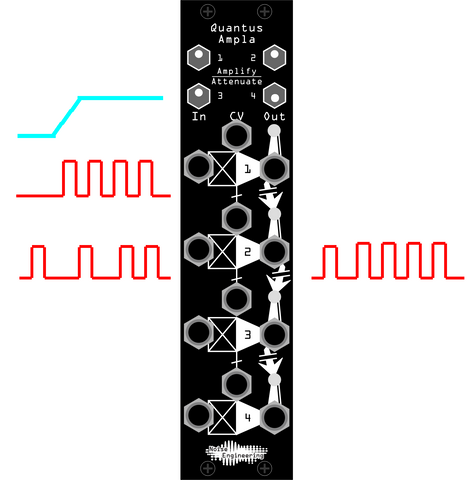Using Stuff Wrong #6: Quantus Ampla for CVable trigger mixing
Welcome back to Using Stuff Wrong, the series where we use modules for things outside of their original design.
This week, we’ll look at a simple technique to create evolving patches by changing and mixing trigger patterns. Rhythmic changes are a simple and effective way to add variation to a patch, and this technique works great with all sorts of trigger sources.
The concept: Voltage-controlled trigger/gate mixing
In case you’re not familiar with Quantus Ampla, it’s a four-channel VCA and mixer with some helpful normaling, and CV inputs that can be inverted. VCAs are very simple but incredibly useful utilities, but since this is modular, we can patch them in a variety of interesting ways. If you’re not familiar with VCAs, check out our article on the subject for a refresher before we get into this particular patch.
Combining two separate streams of triggers is a relatively simple task, and can be done with most any mixer, or with a dedicated logic utility. Since Quantus Ampla’s outputs sum, we can use it to combine multiple trigger sequences. The extra-fun bit comes from voltage control: we can change parts and introduce new patterns with another sequencer or with manual controls, depending on what we patch where.
Starting simple: voltage-controlled switching
Let’s start with the simplest variation of this patch. Set channel 1 of QA to Amplify and channel 2 to Attenuate, then patch two trigger sequences into channels 1 and 2. Patch Out 2 to a trigger destination like a drum voice, and we’re off – this allows us to switch between our two trigger patterns with a single CV source patched into CV 1.

This configuration makes QA act as a voltage-controlled switch, a useful utility in itself. The CV to control switching can come from something like a clock divider for consistent switching, or from a CV or gate sequencer for more complex switching patterns. Or, patch in something like Lapsus Os to control switching manually.
Since Quantus Ampla has 4 channels, we can create this patch twice. By patching more triggers into ins 3 and 4, and out 4 to a destination, we can either control pattern switching over two voices with a single CV signal patched to CV 1, or we can swap them separately by patching another CV source to CV 3.
Next level: trigger mixing
Swapping between two different patterns is one thing, but we can get really complex if we introduce some mixing to our patch. By setting all four channels to Amplify and patching trigger sequences (or clocks, or random trigger generators) to a number of channels, we can automate what patterns are active when with a CV sequencer like Mimetic Digitalis. Since Mimetic Digitalis has four CV outs, we could run it with a slow clock and drastically change our trigger sequences over the course of a patch. And since QA can mix signals, we can blend trigger patterns together, too, instead of just swapping between them. This sort of technique can add a lot of complexity to a patch and keep things from getting repetitive. Here, we have four trigger patterns out of Zularic Repetitor going into Quantus Ampla, and pattern switching and mixing is controlled by Mimetic Digitalis.





